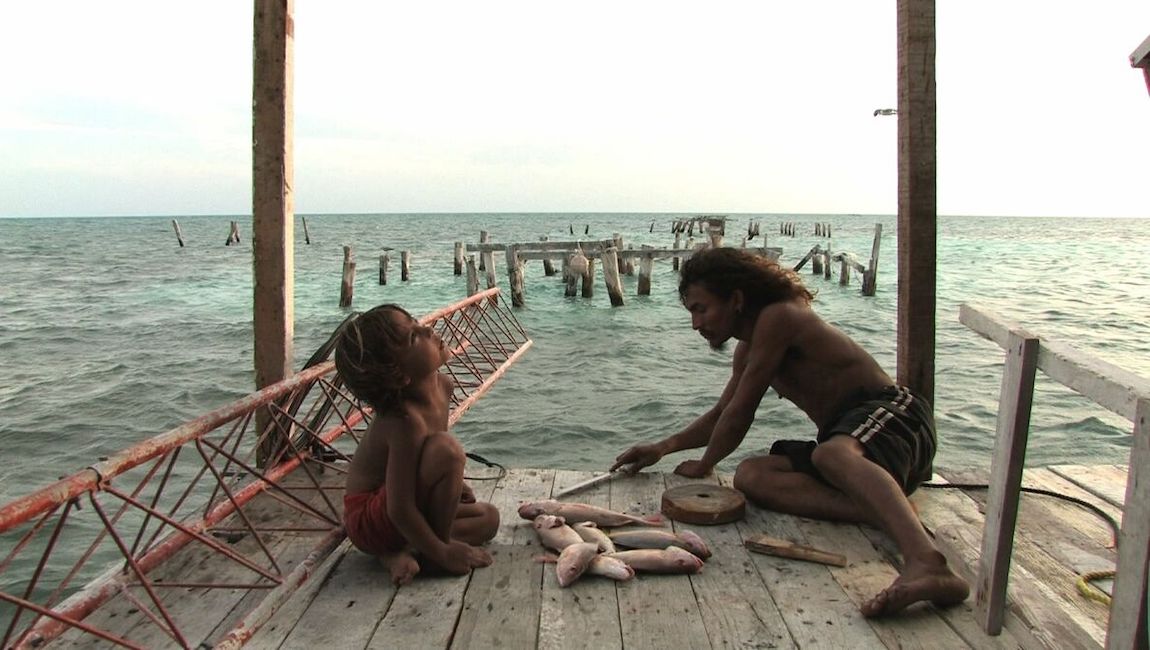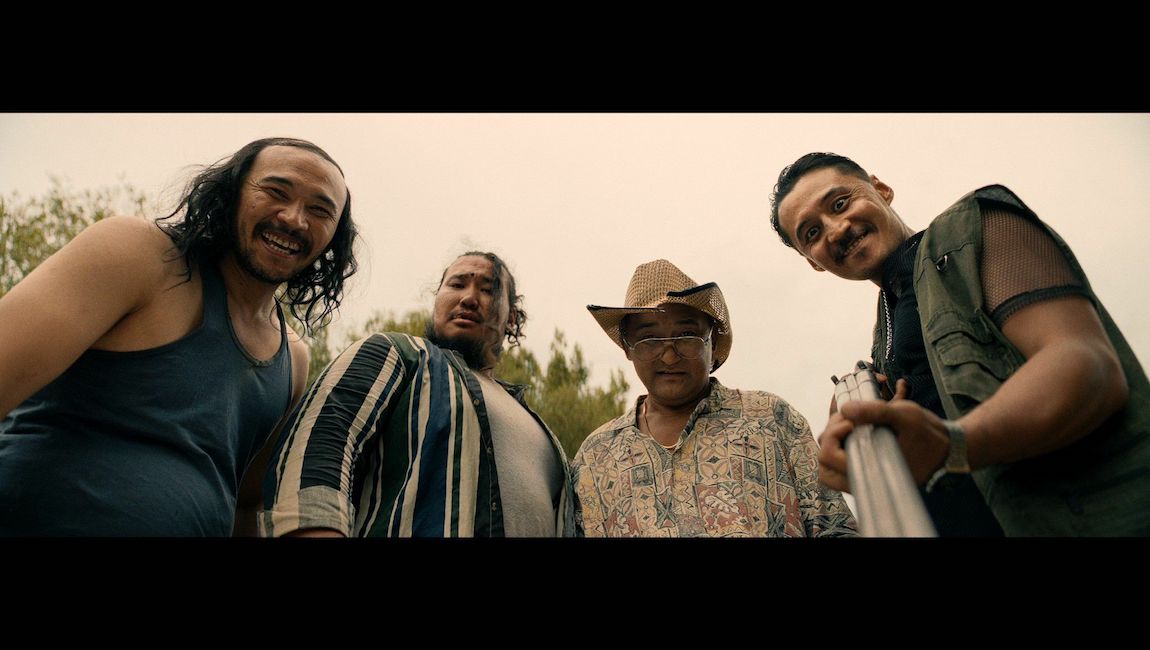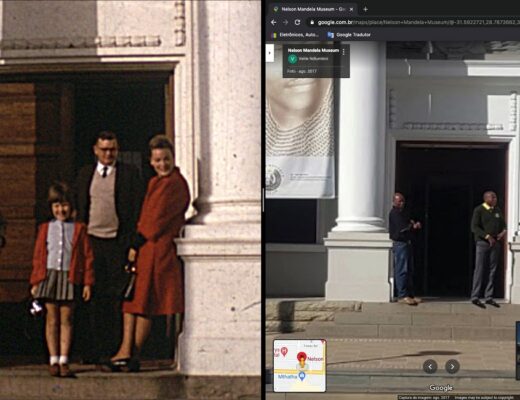Some fathers are born, some are made, and some were never meant to be. Jorge Machado, a Mayan fisherman, was evidently born to be a father—every motion and facial tick suggests as much under the proving stare of Pedro González-Rubio’s lens. Alamar (aka To the Sea) is a study of fatherhood as a binding maleness between generations and a force of nature, an event as sublime as a maritime sunset or storm. If González-Rubio’s ephemeral little film is fixated on beauty, fatherhood in its ideal form possesses an aesthetic as riveting as a tropical lagoon or a perfect body. There’s no ugliness in Alamar; its setting, its actors, its scenes, and its themes are idyllic — a space filled, for the most part, with charming faces, balmy days, and connections between the living that are too sweet to exist for long. Everything is tenuous, from an old man’s lingering agility to a reef’s sustainability. Into this context slip Jorge and his five-year-old son, Natan, a devoted pair separated by circumstance. Jorge’s three-year relationship with an urban Italian appears in photos and home video to have been sweetly tenuous in its own way while it lasted. “Unhappy with each other’s reality,” Jorge and Roberta are forced to revert back to their original environments, which means Natan will soon be living with his mother in Rome while Jorge remains in Mexico.
Barefoot, Jorge collects his son for an extended father-son visit on the coast, where he hopes to instruct Natan about his Mayan heritage before his Italian upbringing defines him. It’s a credit to González-Rubio that his film suggests an indeterminate reality — or an indeterminate fiction. Jorge, Natan, Roberta, and Jorge’s father Nestór are real people who have allowed González-Rubio to document their very real situation. But Alamar barely comes off as a documentary because of its pellucid loveliness and the arc of its incidents. The appearance of an African egret, for example, is symbolically felicitous — both bird and son are destined to fly over the ocean despite being happily nurtured by local hands. Alamar can be seen as very successful neo-realism until the moment Jorge lifts his son from a boat with an imaginative tangle of limbs too expert and automatic to be mere performance. Suddenly, unquestionably, Jorge is no actor. That man is a father, and that boy is that father’s son. Those of us who’ve witnessed a loving dad shift his child’s body against his own with equal parts tenderness and vigilance can’t miss the truth in that moment. Jorge — at least within the frame of Natan’s Mayan summer — is Fatherhood as we should all experience it in our fifth year. “You can’t be a fisherman without patience,” he tells Natan, moments after chiding him for tangling up a line. In this instant, González-Rubio’s main conceit reveals itself; you can’t be a father without great patience, either, and watching that patience unfold as Jorge and Natan improve their skills under the guidance of Nestór sews the film’s images together with an emotive ah.
Life is good in Nestór’s cabin, which sits on stilts in a turquoise lagoon. The three generations bond over barracuda and tortillas or spicy fish stews when they aren’t spearing lobsters out of a reef’s crannies. They paint the cabin’s walls a heart-warming yellow on Natan’s arrival—another symbolic action too apt to be accident, which pulls the film away from documentation again and confounds categories of the real and ideal. Jorge and Natan wrestle, play with Blanquita the egret, and explore nearby sandbars. (When they climb a ladder up to a lookout tower, it recalls Zvyagintsev’s The Return, which features a similar ladder and a similar obsession with fathers and sons — only with a father who’s the very antithesis of Jorge.) Natan learns how to snorkel, how to scale a fish, how to feed a bird out of his hand. He learns Latinate names for local flora and how to co-exist with salt-water crocs. He devours his father’s lore. He has an opportunity to get to know his Mayan grandfather better, a contented fisherman who lives in a masculine world of boats, nets, docks, and pin-up girls, and who’s eager to teach son and grandson alike how to whitewash a hull or cook the day’s catch, how to find satisfaction in a cup of coffee and a ravishing view.
More importantly, Natan learns about trust by being trusted and learns about love by being loved. His father treats him with palpable affection, and the physical appeal of both characters invites us to share that affection effortlessly and to understand its significance. Jorge, one of the most beautiful men ever seen onscreen, is made more so by González-Rubio’s cinematography and editing — if he falters as a parent while Natan is in his care, we never see it. He nurtures his son’s native curiosity, never underestimating Natan’s intelligence or speaking down to him. The light of ideal fatherhood lights up Jorge’s face and superadds to the striking contours of his features, his hair, and his lithe frame. He’s as charismatic as his perfect little son, which mitigates any romanticization of lifestyle or critique of indoctrination that could be read into the film (and you’d need a shoehorn to do so). Jorge and Natan complement the beauty of the environment, which is offered up, cinematically, as a softly gleaming seascape of rippling moments. González-Rubio locates the fluidity of human motion above and below the water’s surface. His framing simplifies the loveliness of an egret or a deep-sea sponge, and he gifts us with extended, breathing takes in order to create a sense of life as anticipation, as flight, even as it studies the nuances of routine.
Alamar is a pearl of a movie thanks to its beauty, but also because it’s so rare and precise. Though it deals with enormous ideas, it contains no lard, and though it’s steeped in sentiment, it rings no false notes. Stripped to a mere 73 minutes and striving for Aristotelian unities, it’s more spare and yet somehow more full than the neo-realistic style that obviously informs it. It provides its narrative and visuals with everything they need to communicate their message, and no more. What it does provide is among the best to be found in cinema: trueness of character, significance of story, and loveliness of scene. The lapis ocean, the white bird, the browning boy, and the gilded father are emblems of things solid and fleeting at once; lasting commitment is set up against the ephemera of youth, weather, and time. It’s no accident that the movie’s inhabitants depend on the Banco Chincorra, one of the most significant coral reefs in the world. González-Rubio makes much of his location visually and thematically, but father(s) and son(s) are never upstaged by the scenery. They are part of it. Diving over the side of a boat, Nestór’s spryness is captured in quick-flashing reflections, as if the sun and water sustain him as much as the fish he depends on do — as if he’s as much a part of the day as the elements are. Age has no meaning here, except as a generational point; we sense Jorge wants to raise Natan the way he was raised by Nestór, but lifestyle is only the half of it. Tenderness and respect are the real parental goals. Alamar is The Old Man and the Sea writ younger: Jorge wrestles to defeat another kind of sorrow in a life made to look as deceptively simple as Santiago’s, within a deceptively simple narrative.







